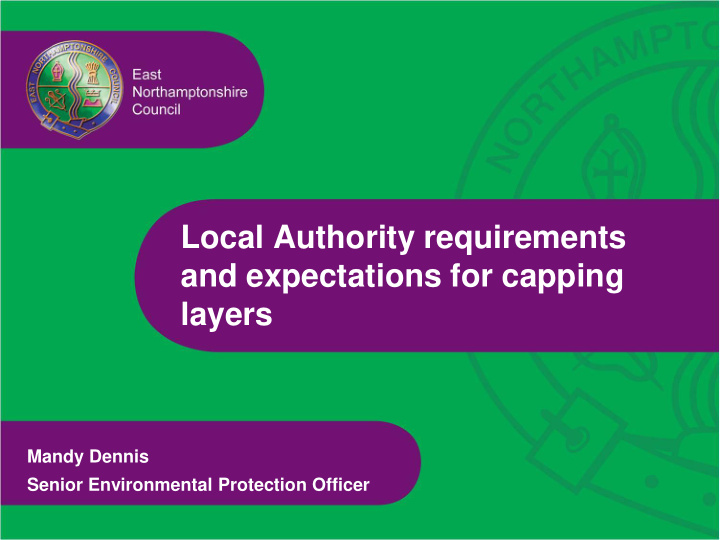



Local Authority requirements and expectations for capping layers Mandy Dennis Senior Environmental Protection Officer
ITS NOT ROCKET SCIENCE! clipartimage.com
Made or natural ground Uncontaminated ground Typical scenario
The National Planning Policy Framework (NPPF) 2018 • Section 178 • a) - planning decisions should ensure a site is suitable for its proposed use……. • b) - after remediation, as a minimum, land should not be capable of being determined as contaminated land under Part IIA of the Environmental Protection Act 1990….. • c) - adequate site investigation information, prepared by a competent person, is available to inform these assessments. • Section 179 - Where a site is affected by contamination or land stability issues, responsibility for securing a safe development rests with the developer and/or landowner.
What do I look for • Robust site investigation • Good conceptual site model • Confidence in the developer • Confidence in the consultant • Site specific requirements • Source of capping material
The Conceptual Site Model • Understand the proposed end use • Identify sensitive areas such as gardens and allotments • Base remediation on sound site investigation information • Appropriate risk assessments • Zoning • More testing? • Know the formation levels – don’t fall foul of planning!
Back to basics: Why is cover needed? • To break the pollutant linkage • Acts as a barrier to underlying contamination • Provides a growing medium Factors affecting the cover system • Presence of soil gases or vapours • Groundwater mobility, level and solubility of contaminants • Slope stability • Excavations • Burrowing animals
IS CAPPING REQUIRED?
Not all capping is soil
Four easy steps • Who does what and why • Design technical specification • Carry out the work • Validation
Who does what and why! • The developer • The consultant • NHBC • The regulator
Design specification – simple soil cap • Understand your conceptual site model • It is considered a reasonable assumption that any disturbance or intermixing of soils is unlikely to exceed 600mm depth from earthworm activity, double digging, root depth, etc • Site specific assessment using appropriate model eg ‘Cover systems for land regeneration – thickness of cover systems for contaminated land’ prepared by RSK ENSR Ltd
Sources of soil capping • Site won (CL:aire Definition of Waste Code of Practise and material management plans) • Processed/manufactured (Eg British Sugar, enriched quarry overburden) • Greenfield site • Topsoil supplier • Builders mate down the road
Laying the soil cap This is the easy bit or is it! How much do I need? Standard 8 wheel tipper truck carries 20 tonnes or 15 cubic metres of soil A 5x5m square garden to 600mm will take 15m 3 Small gardens Big gardens Access Levels
Questions for your soil supplier • Where does the soil come from? • Natural or manufactured? • Is it all coming from the same place? • Is it free from invasive weeds – Japanese Knotweed? • How was it sampled? • Has it been independently tested? • Does the laboratory have MCERTS accreditation? • When was it tested?
Verification or how do I know its been done properly Sampling rates • Many Local Authorities produce guidance • NHBC • Site or source specific Test results Depth profiling • Third party • Site inspection
Soil test results – can be tricky
This is better
Verification
Depth profile Photographs Go and have a look Depth of excavation
It can be complicated!
Soil capping and trees • Tree protection orders • Public open space • Prickly planting
Trees • Most tree roots are located in the top 150 to 600mm (6 to 24 inches) of the soil • About 10% go deeper • Feeder roots absorb water, oxygen and minerals they grow outwards and upwards from the main roots near the soil surface • Water, oxygen and minerals are more abundant at the surface • Root growth (direction) affected by soil compaction, obstructions, etc
Soil capping around retained tree with TPO in public open space Problem – sulphate bearing red shale Mitigation • Remove any red shale (hand digging) to a depth of 300mm • Are not to sever any roots, if cut by accident then should be trimmed with a sharp blade • Work in small sections covering exposed roots with wet sacking • Minimise exposure of roots to air to prevent drying out • Sharp sand placed around exposed roots and covered with topsoil The tree in 2005 • No compaction of topsoil
The tree last Wednesday The tree in 2013
Former rifle range
Landscaping plan
Former landfill site • Near surface metals and PAHs • 300mm soil capping where possible • Prickly planting • Fencing
THANK YOU FOR LISTENING Mandy Dennis Senior Environmental protection Officer 01832 742037 mdennis@east-northamptonshire.gov.uk
Recommend
More recommend